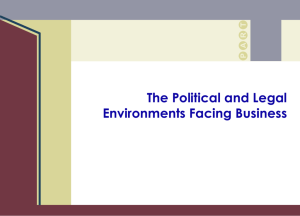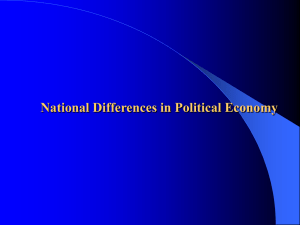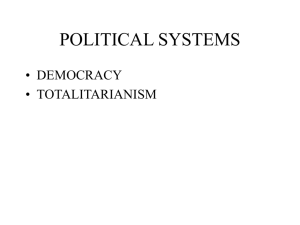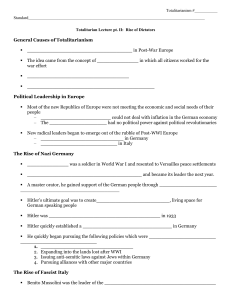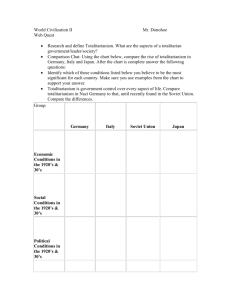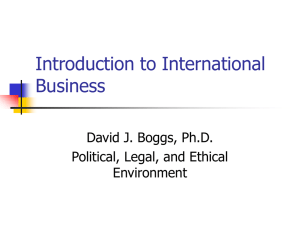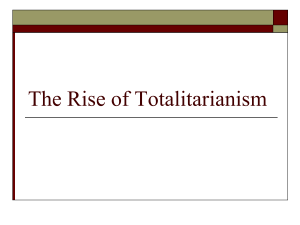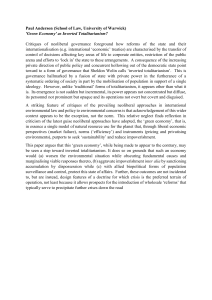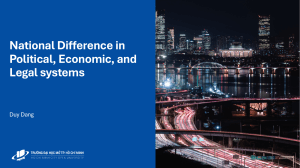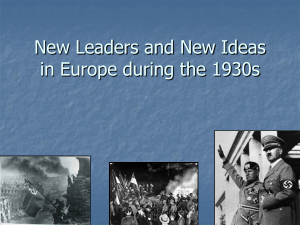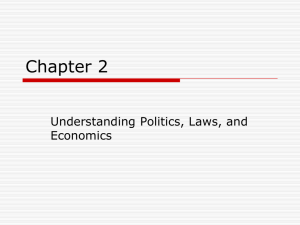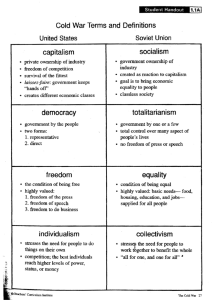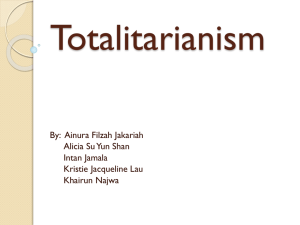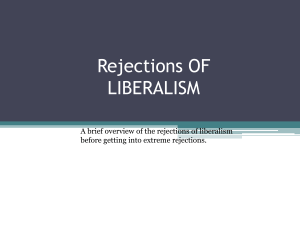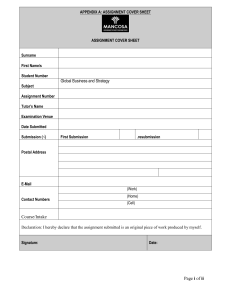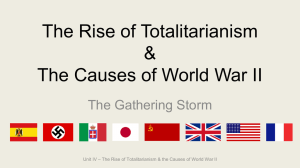Political environments
advertisement
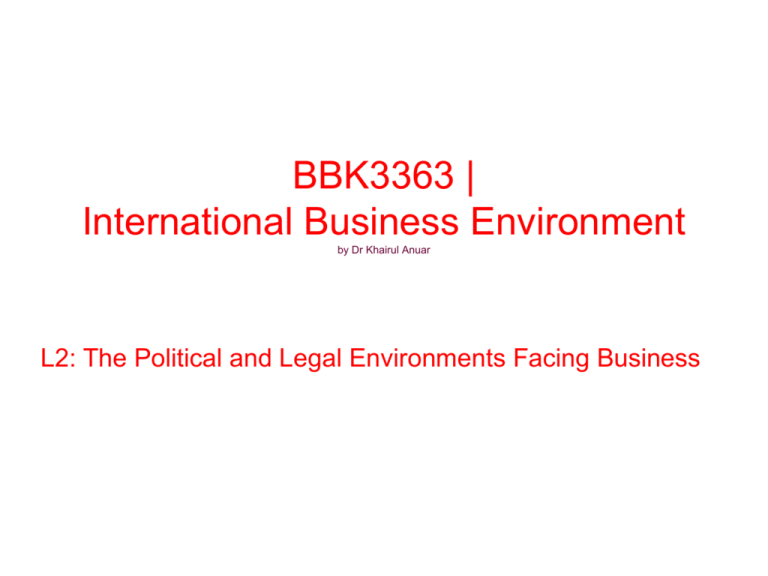
BBK3363 | International Business Environment by Dr Khairul Anuar L2: The Political and Legal Environments Facing Business 1 Topics under International Business Environment • • • • • • • • • 2 The International Business Environment The Competitive Environment The International Economic Environment The Technological Environment The International Cultural, Demographic and Social Environment The Ecological Environment The International Political Environment The Legal Environment Globalisation, challenges and changes Textbooks • The International Business Environment by Leslie Hamilton and Phlip Webster • The International Business Environment: Challenges and Changes, by Ian Brooks, Jamie Weatherston and Graham Wilkinson 3 Chapter Objectives • • • • • • To discuss the philosophies and practices of a political system To profile trends in contemporary political systems To explain the idea of political risk and describe approaches to managing it To discuss philosophies and practices of the legal system To describe trends in contemporary legal systems To explain legal issues facing international companies 3-4 Political and Legal Factors Influencing International Business Operations 3-5 The International Political Environment • • • • Political decisions affect all aspects of the business environment Political decisions reflect underlying ideologies or beliefs Political decisions can create opportunities or threats for organisations Political decisions are taken at a variety of levels Geo-Political Scales • • • • • • Political decisions are taken at different levels Local e.g. Cyberjaya State/Regional e.g. Selangor National e.g. Malaysia Regional e.g. ASEAN Global e.g. World Trade Organisation A Global Scale • • The United Nations The Bretton Woods institutions • • • • The World Bank The International Monetary Fund The World Trade Organisation The G20 A Regional Scale • Regional Co-operation agreements • • • • • • • ASEAN CARICOM EAC EU Mercosur NAFTA SADC A National Scale • The nation state (for example the UK, Japan, Brazil, the USA, Tanzania, Australia) , based on: • • • • Sovereignty Territoriality Authority Legitimacy A Local Scale • • • • • The level below the nation state – but many variations in size, scale and scope. Examples include: California (a state of the USA) Marin County (within California) Leeds City Council (in the UK) St Brelade (a parish on the island of Jersey) Systems of Government • • • • • Different ways of classifying may be found Democratic/ Authoritarian/ Theocratic/ Military Communist/ Capitalist Centralised/ Federal One-party/ Multiparty Functions of Government • • • Legislative Administrative Judicial The Role of Government • • • • • • Much debated! And much changing over time Interventionist (eg UK 1945-1979) Liberal/ Free-market (eg UK 1979-2008) Back to intervention (eg UK 2009) And, perhaps, back to liberalism (UK 2010) Risk and Stability • • • Companies like certainty in their environment Companies tend to invest where risk is limited Risk comes from many sources, including: • • • • Political instability Corruption Terrorism Climate change Definition of a Political System • • The complete set of institutions, political organizations, and interest groups, The relationships among institutions, and the political norms and rules that govern their functions 3-16 Political environments • Political environments may range from a democratic system to communism with other variations between these ideological extremes. • In international construction, like in international business, one has to deal with governments as they are presently structured with all their diversity, and even regressiveness. 3-17 Individualism vs. Collectivism • • Individualism: primacy of the rights and role of the individual Collectivism: primacy of the rights and role of the community 3-18 Political Ideology • • The system of ideas that expresses the goals, theories, and aims of a sociopolitical program Most modern societies are pluralistic— different groups champion competing political ideologies 3-19 The Political Spectrum Reactionary (or reactionist) is a political epithet typically applied to extreme ideological conservatism, especially that which wishes to return to a real or imagined old order of things, and which is willing to use coercive means to do so. 3-20 The Political Spectrum Reactionary (or reactionist) is a political epithet typically applied to extreme ideological conservatism, especially that which wishes to return to a real or imagined old order of things, and which is willing to use coercive means to do so. Consevative - Right-wing, anti-federalist . Prefer smaller government, less regulation, most services to be provided by the private sector in a free market, and a literal interpretation of the Constitution. Liberal - Left wing, federalist. Prefer more regulation and services like free universal health care to be provided by the government to all citizens. Political radicalism denotes political principles focused on altering social structures through revolutionary means and changing value systems in fundamental ways 3-21 Democracy • • Wide participation by citizens in the decisionmaking process Five types: Parliamentary Liberal Multiparty Representative Social 3-22 Fundamental Elements of Democratic Political Systems 3-23 Totalitarianism • Totalitarianism is the other side of the political spectrum. • Major features include: • An individual, a single party, or a select group of individuals monopolizes political power • Non-recognition of any opposition • Decision making is restricted to an individual or a select group of individuals • All societal resources are monopolized by the state 3-24 Totalitarianism • • Restricts decision making to a few individuals Types: • • • • Authoritarianism Fascism Secular totalitarianism - Secularism is based on the principle that affairs of this world should be the most important concerns for ethics and human life. Secular totalitarianism, therefore, is based on worldly rather than religious concepts. Theocratic totalitarianism - : Political control is vested on religious leaders. 3-25 Trends in Political Systems • • Third Wave of Democracy Engines of Democracy 1. The failure of totalitarian regimes to deliver economic progress 2. Improved communications technology 3. Economic dividends of increasing political freedom 3-26 Political Risk In the broad context of international business, political risk is defined as the risk or probability of occurrence of some political events that will change the prospects for the profitability of a given investment. Macro-political risk events include sociopolitical disorder, power group transfer, and political corruption as well as government interference. 3-27 Definition of Political Risk • The risk that political decisions or events in a country negatively affect the profitability or sustainability of an investment • Types: Systemic Procedural Distributive Catastrophic 3-28 Measuring Political Risk • Instability: The probability of encountering political risk in a host country is considered to be directly related to the relative stability the country's political system. This instability may have its roots in different economic, political, and social factors. Some specific causal factors may include communal unrest, strained international relations with neighboring countries • Past patterns: Past patterns of political behavior is analyzed to determine political risk involved. However, predicting political risk on the basis of historical records has its own drawbacks. Political situations under which risks were encountered by companies or individuals in the past might have changed altogether; (e.g. Vietnam). • Opinion analysis: Political risk may also be measured qualitatively by examining the views of people engaged in governmental decision making and people who may influence future political events affecting business. 3-29 Political Risk Management • Avoidance: Selecting only safe environments for business and rejecting regions that are perceived to have greater than average degree of political risk. • Premium for risk: Increasing the ROI (return on investment) or requiring shorter period of payback. • Adaptation: Responding to the particular political environment of the host country and structuring the international operations accordingly (e.g. adapting to the local methods, utilization of host country professional expertise, joint venture, etc.). • Transfer: Sharing of risks with other individuals or companies or reducing the risks through transfer to other agencies. 3-30 Political Strategies for conducting International Business • Some of the steps that an individual or a company may follow in order to establish political strategies: Identifying the issue (e.g. protectionism, environmental standards, human rights, workers rights, etc.) Defining the nature of the political issue Assessing the potential political action of other firms and of special interest groups Identifying important institutions and key individuals Formulation of strategies (objectives, alternatives) Determining the impact of implementation (both in home and host countries) Selection of the most appropriate strategy and implementation. 3-31 Conclusion • The political environment is both complex and dynamic • Individuals and organisations have different views as to the ‘correct’ role of governments and institutions – and interpret these relationships in different ways • Government and institutional attitudes change over time, sometimes amazingly quickly • Decisions at the four different geo-political levels are all interlinked • International aspects are increasingly important
